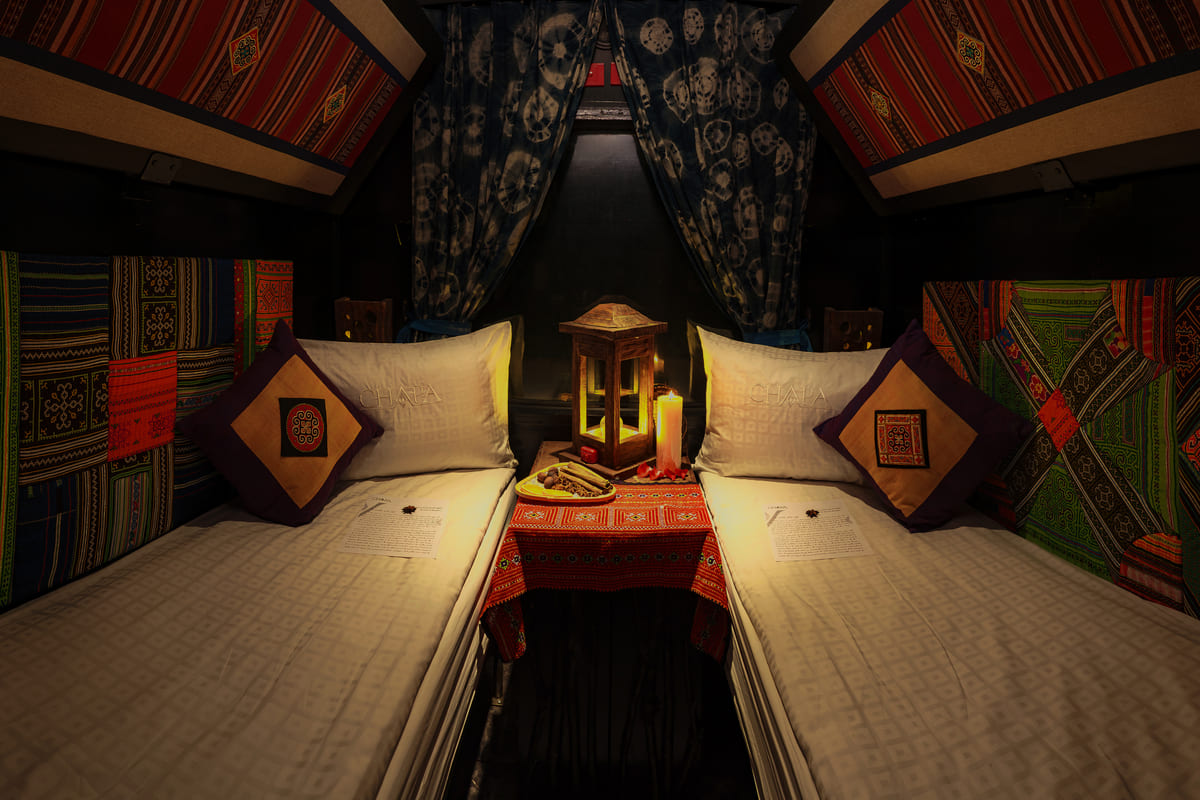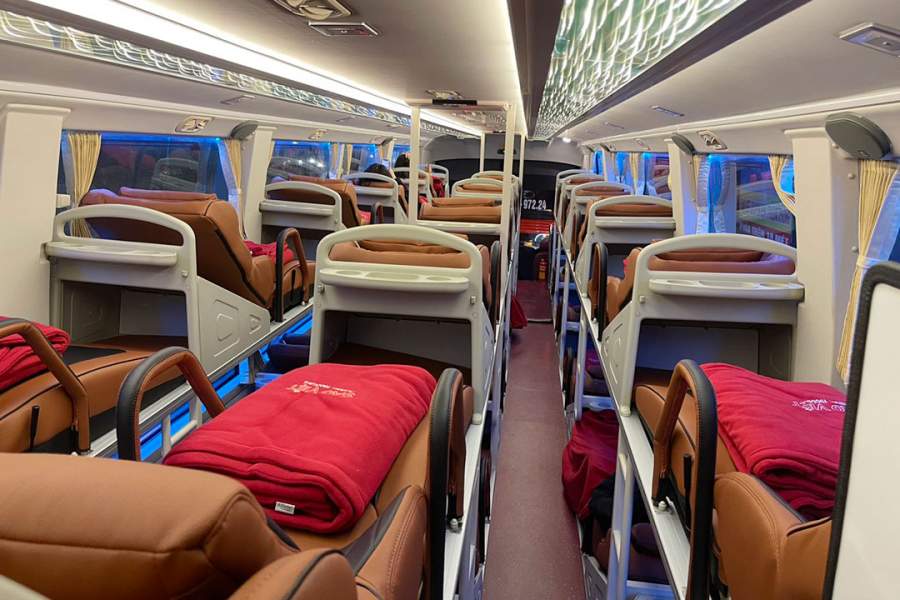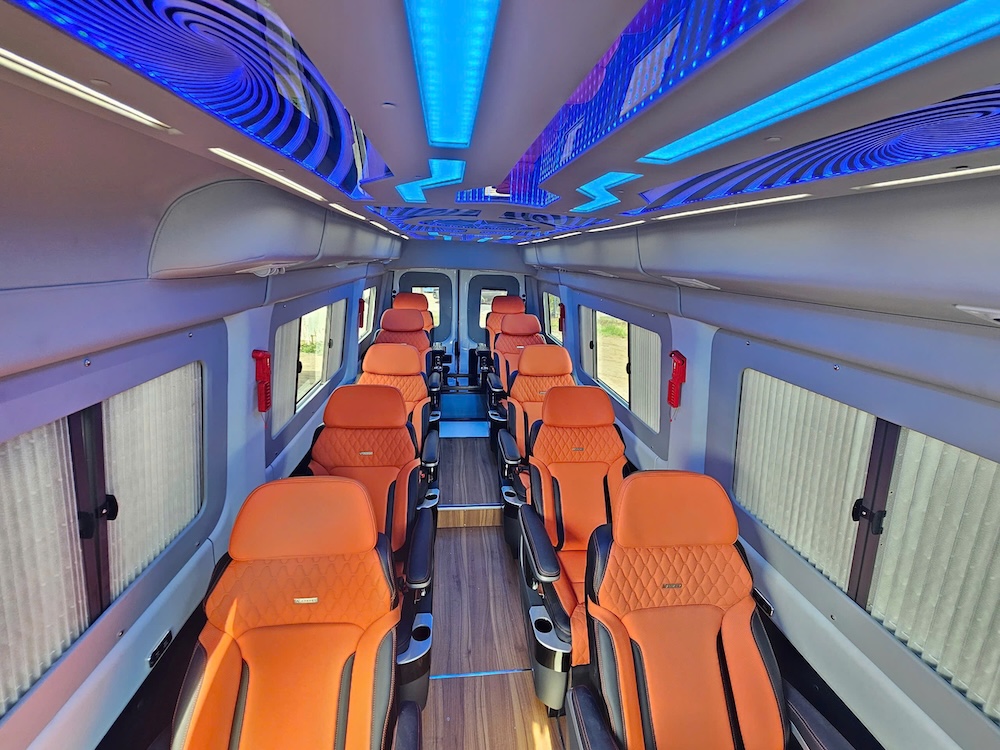Discover Sapa
How To Get From Hanoi To Sapa: 3 Best Ways To Travel
For most travelers, getting from one place to another is the least enjoyable part of any trip. But Vietnam's stunning mountainous region of Sapa in Lao Cai province makes this journey an exception.
Since flights aren't available, join us on this 350-kilometer adventure from Hanoi to discover the best ways to reach Sapa. This comprehensive guide covers three transportation options - tourist train, bus & private car, weighing the pros and cons of each and offering practical booking tips to ensure your journey is as memorable as your destination.
Option 1: Tourist Train - The Historic Experience

Tourist trains include shared or private cabins, accommodating 2 - 4 passengers only (Photo: Chapa Express Train)
The overnight train offers both standard and premium coaches. Premium services, operated by independent providers, convert regular cabins into comfortable hotel-style accommodations for travelers wanting a more luxurious experience. Choose between 2-berth or 4-berth cabins. For privacy, you can book an entire cabin rather than sharing with other passengers.
- Journey time: 8 hours (Hanoi to Lao Cai) + 1.5 hours (Lao Cai to Sapa)
- Cost: US$ 17 - 140/person (based on standard or premium train, Deluxe or Vip berth, shared or private cabin)
- Departure times: 22:00 and 22:40 daily
Pros
- Historic charm: Vietnam's century-old railway system with vintage carriages offers an authentic Southeast Asian travel adventure.
- Superior safety: Travel on dedicated railway tracks away from dangerous mountain roads, providing predictable journey conditions unaffected by weather, traffic, or road hazards.
- Comfortable accommodation: Spacious beds with leg room, private facilities and the ability to move around carriages freely.
- Morning mountain scenery: Brief mountain views during early morning hours
Cons
- Longest total journey time: Train travel and road transfer exceeds bus travel by 2-3 hours.
- Noise and movement: Constant rattling, shaking, and station stops throughout the night can disturb rest for light sleepers.
- Limited schedules: Only two nightly departures available with no daytime options.
- Additional transfer cost: A separate 1 to 1.5-hour bus or taxi transfer from Lao Cai station to Sapa adds cost to the total.
- Ticket exchange needed: Physical ticket exchange is required, creating potential complications for travelers with tight schedules.
Booking & Price
All trains terminate at Lao Cai station, requiring an additional 1 to 1.5-hour journey to reach Sapa town.
For standard berths booked through the official Hanoi Railway Transport Joint Stock Company website, you can select the shuttle bus service option for VND 55,000 (~US$2.2) per person by ticking the box below:

For premium berths booked through travel agencies or train operators, you can request a proper transportation arrangement for a surcharge (based on each operator).
Essential notes:
- At the station, check the display screen to locate your train’s platform. Your ticket shows your coach and seat/bed numbers.
- No dining carriage is available - only items provided by your travel agent or included in your cabin are complimentary.
- Keep valuables with you when leaving your cabin, as compartments can only be locked from inside.
Recommended train operators:
|
Train Operators |
4-berth (per way) |
2-berth (per way) |
Departure Time |
Contact Info |
|
Vietnam Railways |
1st floor: VND 441,000/person VND 461,000/person 2nd floor: VND 420,000/person VND 440,000/person |
VND 619,000/person |
22:00 22:40 |
Hotline: 1900 0109 Train Station: 120 Le Duan |
|
Vic Sapa Train |
$45/person |
$150/Cabin Vip 2 $160/Cabin Vip 1 $195/Suite Cabin |
22:00 22:40 |
Hotline: 0345 684 688 0985 797 247 Office: R324 - 142 Le Duan |
|
Chapa Express Train |
$42 - 59/person |
$176/VIP Cabin $195/Suite Twin Cabin $239/Grand Suite Cabin $379/Grand Suite Queen Cabin |
22:00 22:40 |
Hotline: 0912 200 683 0812 321 983 Office: 2nd floor, Ha Noi Station, 120 Le Duan |
|
King Sapa Train |
$36.2/person |
$145.2/Private Suite $158.4/Vip Twin $171.6/Vip Double |
22:00 22:40 |
Hotline: 0914 991 788 Office: 36A/178 Kham Thien |
Option 2: Bus - The Cost-Effective Choice
Sleeper Bus

Sleeper buses include 34 to 40 soft berths (Photo: xekhachsaoviet)
Sleeper buses offer private sleeping compartments equipped with reclining beds, pillows, blankets, privacy curtains, individual TV screens, Wi-Fi (though connectivity can be spotty), USB charging ports, and complimentary water. Premium coaches may include additional amenities like reading lights, headphones, and massage functions. Upon boarding, staff provide shoe storage bags with dedicated compartments behind your bed. All buses have air conditioning with individual climate controls for personalized comfort.
-
Journey time: 5.5 - 6 hours
-
Cost: Starting from VND 400,000 (~ US$16) per way
- Notes: Arrive 30 minutes before departure, or 45 minutes early if using hotel pickup service from Hanoi's Old Quarter to account for traffic and multiple collection stops.
Pros
- Most economical option: Ideal for budget-conscious travelers who prefer trekking, homestays, and cultural activities rather than premium transportation costs.
- Comfortable travel: Private sleeping cabins are equipped with reclining beds, climate control, and privacy features..
- Flexible schedule: Multiple buses depart throughout the day from early morning to late night, accommodating any travel schedule.
- Modern digital convenience: E-tickets accepted directly through mobile apps, SMS confirmations, or email downloads, eliminating need for physical ticket collection or printed documents.
- Direct destination service: Most buses travel straight to Sapa town center, saving time and eliminating the complications of changing transportation.
Cons
- No onboard restrooms: Expect 1-2 bathroom/snack stops during the journey
- Space limitations: Sleeping compartments may feel cramped for travelers over 6 feet tall, with limited headroom and bed length.
- Last-minute changes: Bus numbers, pickup locations, and departure terminals can change last-minute without advance notice.
- Shoe storage required: All passengers must remove footwear upon boarding and store shoes in provided bags within designated compartments.
Booking & Price
Booking Sapa buses is now easy for international travelers, with English-language websites and customer service available. Complete reservations online in 3-5 minutes, by phone, or ask your hotel/tour operator to book for you. Here are some essential tips for you:
- Book through reputable operators or your hotel
- Check seat capacity: Choose 22-24 seat buses for proper sleeper cabins with adequate space. Avoid cramped 34-seat buses with poor legroom and privacy.
- Verify destination: Ensure tickets show "Sapa" as the final stop. Cheaper tickets may end in Lao Cai city, 38 km away, requiring additional transfers.
- Monitor your email for any schedule changes
Recommended Sleeper Bus Operators:
|
Sleeper bus |
Price (VND/way) |
Travel time |
Departure time |
Contact info |
|
G8 Sapa Open Tour |
420,000/person |
4h55m |
AM: 0:20, 0:35, 06:30, 07:00, 07:15, 07:45, 09:15, 10:00, 11:00 PM: 13:00, 14:30, 17:00, 22:30, 22:45, 23:05, 23:15, 23:30, 23:45 |
Hotline: 0965.611.611 0961.615.611 Zalo: 0961.615.611 0368.929.611 Office: 105 Hoang Quoc Viet |
|
Sapa Group Bus |
1st floor: - Single cabin: 500,000/person - Double cabin: 700,000/2 people 2nd floor: - Single cabin: 400,000/person - Double cabin: 650,000/2 people |
6hrs |
AM: 6:45 PM: 22:00 |
Hotline: 0385240553 1900 4631 Office: 3b, 19/10 Nguyen Van Huyen |
|
Sao Viet |
1st floor: - Single cabin: 470,000/person - Double cabin: 700,000/2 people 2nd floor: - Single cabin: 400,000/person - Double cabin: 700,000/2 people |
5h30m |
AM: 5:30, 6:00, 07:00, 08:15, 09:00, 10:00, 11:00 PM: 12:00, 13:00, 14:00, 15:00, 16:00, 17:00, 18:00, 19:30, 22:00, 22:30, 23:00, 23:30, 23:59 |
Hotline: 0243 9922 555 090 222 7070 Office: 114 Tran Nhat Duat 789 Giai Phong 7 Pham Van Dong |
|
Inter Bus Lines |
Single cabin: 399,000/person Double cabin: 680,000/2 person |
6hrs |
AM: 05:30 PM: 12:30, 21:00, 21:15 |
Hotline: 0886 385 577 0886 395 577 0868 519 777 1900 1137 Office: BT01, TT3B, Tay Nam Linh Dam |
Limousine Day Bus

Limousine buses offer a quieter space with 9 - 28 soft seats (Photo: Ecosapa Limousine)
Limousine day buses combine the compact exterior of a 16-seat minivan with luxurious interior design reminiscent of high-end limousines. With only 9-11 seats available, these vehicles follow the principle of exclusivity—fewer seats mean higher prices and significantly enhanced comfort levels.
VIP and business-class seats feature generous sizing, fully adjustable armrests, customizable reclining positions, and integrated premium massage functions for ultimate relaxation during your mountain journey.
- Journey time: 5.5 - 6 hours
- Cost: Starting from VND 400,000 (~ US$16) per way & higher by seat class
Pros
- Door-to-door hotel pickup/drop-off: Save transferring time and cost from your location to the departure location.
- Fewer passengers: Enhanced comfort and privacy, suitable for both individuals and small groups renting the whole van.
- Direct driver contact: Drivers contact you personally to confirm pickup details, easy for questions or updates of schedule changes.
- All-day service option: Extended vehicle use for Sapa exploration when booking the whole van.
Cons
- High price: More expensive than sleeper buses
- Limited night departures: Primarily morning and afternoon schedules for safety reasons
- Advance booking essential: Limited seats fill quickly
Booking & Price
Contact operators directly for fastest service and seat availability. They'll coordinate pickup locations, provide vehicle details, and share driver contact information.
Recommended Limousine Bus Operators:
|
Limousine Minivan |
Price (VND/way/person) |
Departure Time |
Contact Info |
|
Ecosapa Limousine |
400,000 - 500,000 |
AM: 7:00 PM: 15:00 |
Hotline: 037 555 6666 Office: 42 Hang Giay |
|
Luxury Van Limousine |
415,000 |
AM: 6:15, 6:20, 6:30, 6:40, 6:50, 7:00 PM: 14:35, 14:40, 14:45 |
Hotline: 19001112 Whatsapp: +84 925 716 555 Office: 16 Hang Chinh |
|
Phuc Lam Limousine |
Front-seat: 370,000 VIP-seat: 520,000 Business-class: 470,000 |
AM: 6:00 PM: 15:15 |
Hotline: 0946 301 333 Office: 489 Nguyen Van Cu |
Option 3: Private car - The Premium Comfort

Private car offers absolute privacy, tailor-made itineraries, and door-to-door service (Photo: Collected)
Private cars are definitely the premium choice for all upscale travelers, whether solo travelers, couples, families, or groups of friends. With plenty of options from 4 to 29 seats, private cars offer absolute privacy, tailor-made itineraries, door-to-door service, and maximum comfort. Instead of waiting for other passengers, you can choose your own departure time and stop for a break at some scenic points, and enjoy a relaxing, exclusive journey to Sapa.
-
Journey time: 5.5 - 6 hours
-
Cost: Starting from VND 2,800,000 (~$112) per 4-seat car per way
-
Departure time: Flexible time upon request, either day or night
Pros
-
Maximum comfort and privacy: Only your party in the car ensures more comfort and privacy throughout the trip, perfect for couples and groups/families.
-
Time saving: No need to pick up and drop off other passengers, private cars are the fastest way to get to Sapa.
-
Direct route & door-to-door service: Private car picks you up at your hotel in Hanoi and drops you off at your hotel in Sapa.
-
Customized schedule: Choose your preferred departure time and custom stops on the way to enjoy the scenery.
Cons
-
High price: Traveling by private car is more costly than bus or train, especially when you book 4 or 7-seat cars for only 2 to 3 people.
-
Limited social connection: Only your group limits the opportunity to connect with other travelers worldwide.
Booking & Price
Prices for private cars from Hanoi to Sapa varied by type of vehicle like Sedan, Suv, Ford Everet, Ford Transit, mini van, etc. Booking a round trip is normally cheaper than separate one way trips. Here is the price range for your preference:
-
4-seat car: VND 2,800,000 - 3,000,000/ way
-
7-seat car: VND 3,000,000 - 3,300,000/ way
-
10-seat car: VND 4,500,000 - 5,000,000/ way
Booking tips:
-
Book via a reputable transport operator for transparent pricing such as Hoabinhbus, AZgo Travel, dichvuthuexe, Sao Dieu, etc.
-
Confirm inclusions and exclusions in the price (fuel, tolls, driver’s overnight stay if booking a round trip)
-
Book a round-trip transfer for a better rate.
-
Save the contact number of the driver before departure.
-
Request a basic English-speaking driver if needed. If not, save the hotline contact for timely support throughout the journey.
Customer Support

- Fast, hassle-free booking: book your train tickets and other service with peace of mind
- Local Support: Our staff is available to answer questions, handle changes, or provide travel updates.
- Personalized Assistance: Get tailored advice on train tickets, hotel options, and tour add-ons










